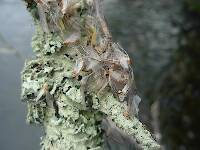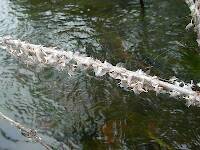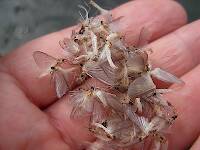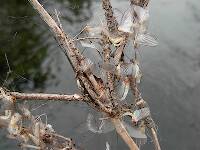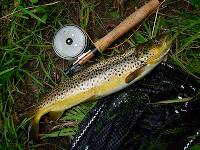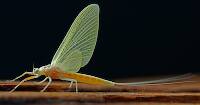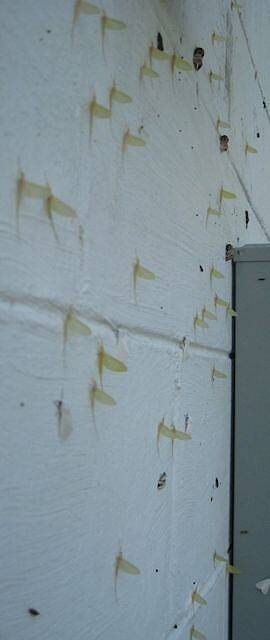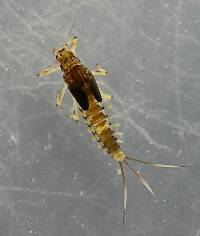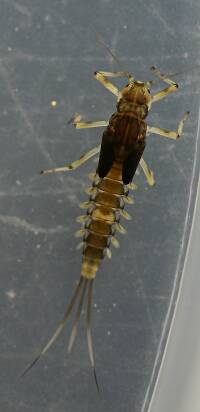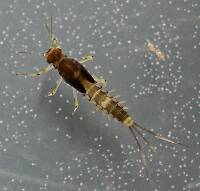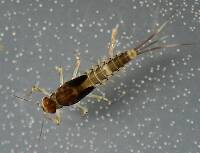
Blue-winged Olives
Baetis
Tiny Baetis mayflies are perhaps the most commonly encountered and imitated by anglers on all American trout streams due to their great abundance, widespread distribution, and trout-friendly emergence habits.
Featured on the forum

Troutnut is a project started in 2003 by salmonid ecologist Jason "Troutnut" Neuswanger to help anglers and
fly tyers unabashedly embrace the entomological side of the sport. Learn more about Troutnut or
support the project for an enhanced experience here.

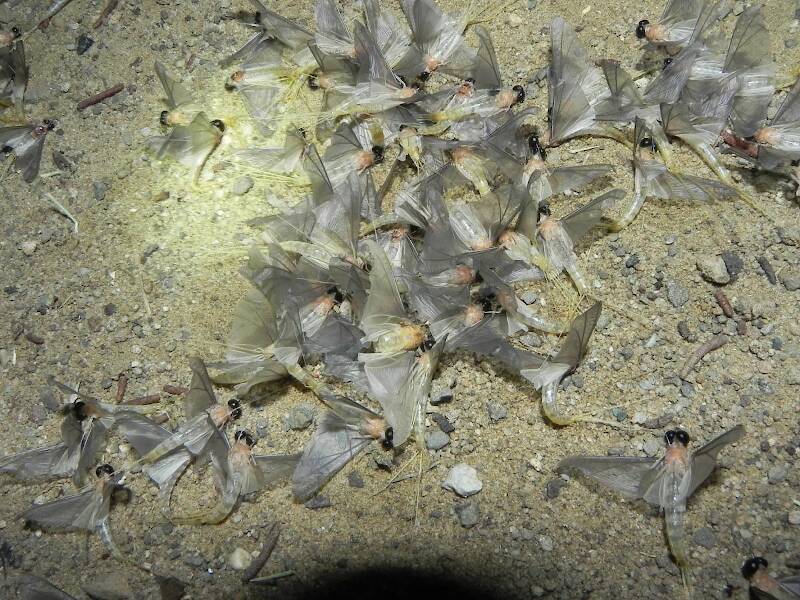
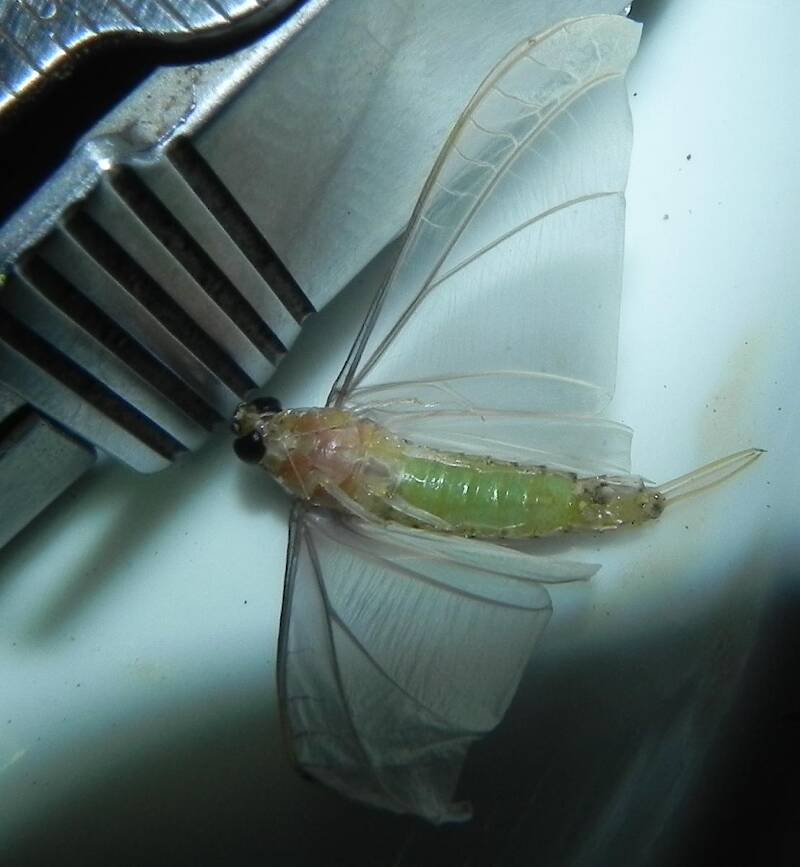
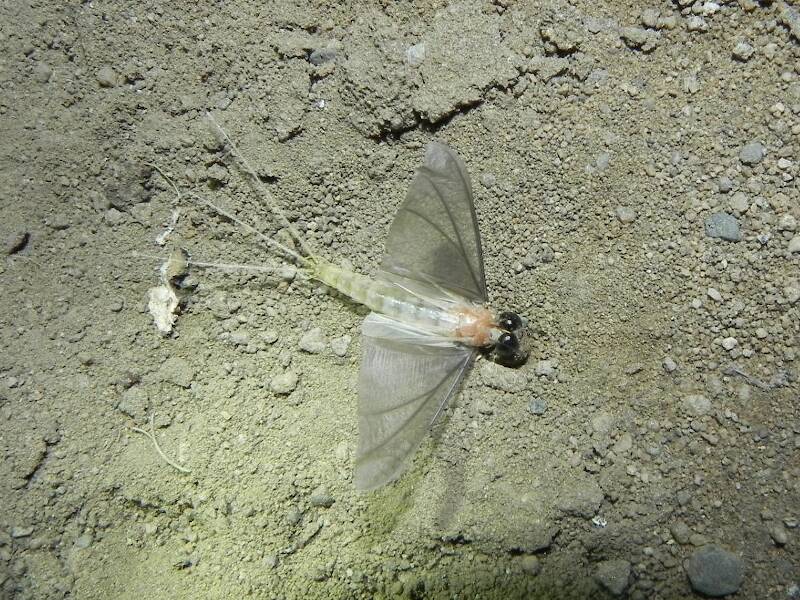
Ntchebe on Mar 11, 2013March 11th, 2013, 7:58 am EDT
Please could someone try and ID this large mayfly found in the Tugela River system near Weenen. According to Helen James of Rhodes Universty its of the Oligoneuriidae family.
The gods do not deduct from man's allotted span the hours spent in fishing.
PaulRoberts on Mar 11, 2013March 11th, 2013, 8:30 am EDT
Neat. Coloration looks convergent with our Ephoron, and Caenis. Wonder what that's about? Ephoron is silt/gravel burrower, yes? Caenis is a silt crawler/sprawler? The adults are open air fliers, that inundate predators with sheer numbers, yes? Very curious.
Is this SA mayfly associated with silt substrate? Does it emerge in huge numbers?
Is this SA mayfly associated with silt substrate? Does it emerge in huge numbers?
Ntchebe on Mar 11, 2013March 11th, 2013, 10:09 am EDT
It emerges at dusk and the males emerge first en masse. They are strong fliers and appear to emerge in large numbers over a short period of time. the female to male ratio was about 1:250
we managed to find two nymphal shucks this afternoon but no sign of any nymphs.
Hatches are triggered by a significant drop in temperature as we had yesterday. Tonight remained overcast but none of this species appeared.
According to a local expert in JHB, there is very little information on this particular species.
we managed to find two nymphal shucks this afternoon but no sign of any nymphs.
Hatches are triggered by a significant drop in temperature as we had yesterday. Tonight remained overcast but none of this species appeared.
According to a local expert in JHB, there is very little information on this particular species.
The gods do not deduct from man's allotted span the hours spent in fishing.
Taxon on Mar 11, 2013March 11th, 2013, 10:13 am EDT
Ntchebe-
My guess would be Oligoneuriella rhenana.
My guess would be Oligoneuriella rhenana.
PaulRoberts on Mar 11, 2013March 11th, 2013, 10:26 am EDT
It emerges at dusk and the males emerge first en masse. They are strong fliers and appear to emerge in large numbers over a short period of time. the female to male ratio was about 1:250
we managed to find two nymphal shucks this afternoon but no sign of any nymphs.
Hatches are triggered by a significant drop in temperature as we had yesterday. Tonight remained overcast but none of this species appeared.
According to a local expert in JHB, there is very little information on this particular species.
Wow. Sounds a lot like our Ephoron. Thanks for sharing.
Entoman on Mar 11, 2013March 11th, 2013, 3:08 pm EDT
Hello Ntchebe -
Welcome to the forum! It is great that to hear from people so far away.
Oligoneuriid's few prominent longitudinal veins make their wings look very bat-like and the easiest way to tell them from our common Ephoron. I believe Taxon is correct, at least to genus. I don't follow world fauna but the three tails is the easiest way to separate our Homoeoneuria from its two-tailed sister genus Lachlania. The only reason I know anything about them is because believe it or not, this strange family is represented here in North America by several species in both genera and not just in southern climes either. I'm not aware of any reported value to fly fishers here, but where flies hatch and fish rise...;)
Here's a link to a photo of the nymph you mentioned as not finding. http://www.lurebg.com/FlyFishing/Praktika/Oligoneuriella-rhenana_big1.jpg
Though its morphology is clearly oligoneuriid, I can't vouch for its accuracy as to claimed species or as a match for your specimen.:)
Best regards,
Welcome to the forum! It is great that to hear from people so far away.
Oligoneuriid's few prominent longitudinal veins make their wings look very bat-like and the easiest way to tell them from our common Ephoron. I believe Taxon is correct, at least to genus. I don't follow world fauna but the three tails is the easiest way to separate our Homoeoneuria from its two-tailed sister genus Lachlania. The only reason I know anything about them is because believe it or not, this strange family is represented here in North America by several species in both genera and not just in southern climes either. I'm not aware of any reported value to fly fishers here, but where flies hatch and fish rise...;)
Here's a link to a photo of the nymph you mentioned as not finding. http://www.lurebg.com/FlyFishing/Praktika/Oligoneuriella-rhenana_big1.jpg
Though its morphology is clearly oligoneuriid, I can't vouch for its accuracy as to claimed species or as a match for your specimen.:)
Best regards,
"It's not that I find fishing so important, it's just that I find all other endeavors of Man equally unimportant... And not nearly as much fun!" Robert Traver, Anatomy of a Fisherman
Martinlf on Mar 11, 2013March 11th, 2013, 5:39 pm EDT
Yikes!
"He spread them a yard and a half. 'And every one that got away is this big.'"
--Fred Chappell
--Fred Chappell
Ntchebe on Mar 12, 2013March 12th, 2013, 12:26 pm EDT
Thank you for your responses! Much appreciated!
Okay so i have found out from Africa's leading authority on mayflies - Helen James - that Oligoneuriella. O. rhenana is European and other species occur in Asia and the Middle East, with a record in North Africa, but it’s not Afrotropical. According to Helen James from the University of Rhodes it is one of the three possible Oligoneuriopsis species, elizabethae, lawrencei or jessicae
Okay so i have found out from Africa's leading authority on mayflies - Helen James - that Oligoneuriella. O. rhenana is European and other species occur in Asia and the Middle East, with a record in North Africa, but it’s not Afrotropical. According to Helen James from the University of Rhodes it is one of the three possible Oligoneuriopsis species, elizabethae, lawrencei or jessicae
The gods do not deduct from man's allotted span the hours spent in fishing.
Entoman on Mar 12, 2013March 12th, 2013, 1:09 pm EDT
Very good. Thanks for getting back with an update!
"It's not that I find fishing so important, it's just that I find all other endeavors of Man equally unimportant... And not nearly as much fun!" Robert Traver, Anatomy of a Fisherman
Entoman on Mar 12, 2013March 12th, 2013, 4:22 pm EDT
Paul,
This strange family is mostly pantropical but we get them over here as far North as Saskatchewan! Our two genera are distinctly different as to habitat preferences and don't really fit into the angler's 4 categories of nymph types. The Homoeoneuria species burrow into the course sand substrate they prefer but don't make tubes like Ephoron. They don't have tusks like our burrowers do either, but the anteriors of their head capsules are spade shaped, suggesting they dig more with their heads than their weak legs that atrophy to near uselessness as adults. Lachlania nymphs have stouter legs and range further North. They behave more like clingers, gripping to sticks and other firm detritus between rocks. They are even found underneath the rocks like a heptageniid. I don't know about Oligoneuriella species, but their less stout legs similar to Homoeoneuria make me think they live in the sand as well. My understanding is that in optimal tropical habitat these critters swarm diurnally in amazing numbers. I think parts of Florida are known to have some real humdingers.:)
Ephoron is silt/gravel burrower, yes? Caenis is a silt crawler/sprawler? The adults are open air fliers, that inundate predators with sheer numbers, yes? Very curious.
Is this SA mayfly associated with silt substrate? Does it emerge in huge numbers?
This strange family is mostly pantropical but we get them over here as far North as Saskatchewan! Our two genera are distinctly different as to habitat preferences and don't really fit into the angler's 4 categories of nymph types. The Homoeoneuria species burrow into the course sand substrate they prefer but don't make tubes like Ephoron. They don't have tusks like our burrowers do either, but the anteriors of their head capsules are spade shaped, suggesting they dig more with their heads than their weak legs that atrophy to near uselessness as adults. Lachlania nymphs have stouter legs and range further North. They behave more like clingers, gripping to sticks and other firm detritus between rocks. They are even found underneath the rocks like a heptageniid. I don't know about Oligoneuriella species, but their less stout legs similar to Homoeoneuria make me think they live in the sand as well. My understanding is that in optimal tropical habitat these critters swarm diurnally in amazing numbers. I think parts of Florida are known to have some real humdingers.:)
"It's not that I find fishing so important, it's just that I find all other endeavors of Man equally unimportant... And not nearly as much fun!" Robert Traver, Anatomy of a Fisherman
Jmd123 on Mar 13, 2013March 13th, 2013, 6:37 pm EDT
Wing venation on this species seems to be much simpler than most mayflies I am used to, looks like just some major veins visible with a few cross-veins and what looks more like pleats to me over the rest of the wing. Or am I not seeing the details? The wings strike me as a bit opalescent too, maybe from the pleated texture?
Do fish go nuts when these things come out? Looks like some solid hatching going on there...
Jonathon
Do fish go nuts when these things come out? Looks like some solid hatching going on there...
Jonathon
No matter how big the one you just caught is, there's always a bigger one out there somewhere...
Entoman on Mar 14, 2013March 14th, 2013, 10:05 am EDT
Yes, looks like jade & pearls doesn't it? You get past what we "expect" mayflies to look like and they are actually quite pretty. They are also in Japan. I wonder if they have been the subject of art there...
"It's not that I find fishing so important, it's just that I find all other endeavors of Man equally unimportant... And not nearly as much fun!" Robert Traver, Anatomy of a Fisherman
Quick Reply
Related Discussions
Topic
Replies
Last Reply
5
Aug 7, 2007
by Wiflyfisher
by Wiflyfisher
3
Dec 9, 2009
by Martinlf
by Martinlf
1
Sep 9, 2008
by GONZO
by GONZO
20
Nov 1, 2011
by Jmd123
by Jmd123









